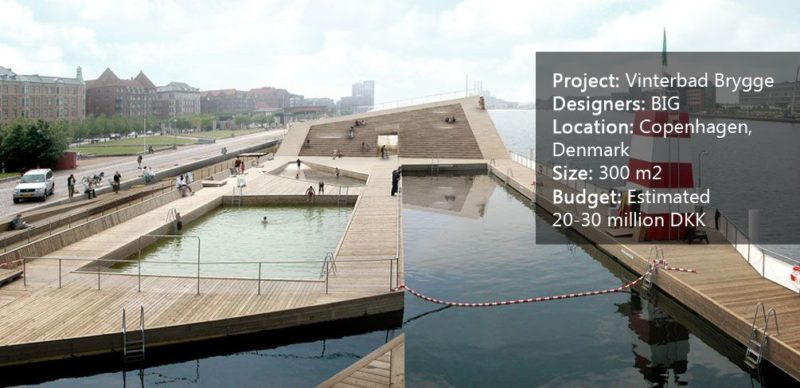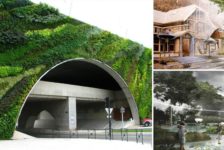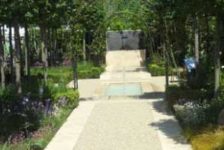Vinterbad Brygge, by BIG in Copenhagen, Denmark. People in Scandinavian countries have a very special perception regarding physical contact with water. The most common ritual is known as the “Nordic Bath” and it originates from Finland. The ritual of a “Nordic Bath” involves alternately taking a dip in cold then hot water. It is an activity that has social, health, and cultural aspects well founded in Scandinavians’ perception of life. The use of thermal baths goes a long way back in the history of these countries, as well as in other countries worldwide. Winter swimming seems to also be a very popular activity in Northern Europe, although the climate would suggest otherwise.
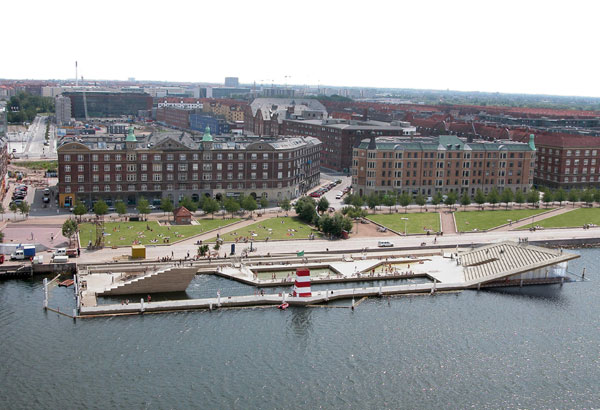
Vinterbad Brygge. Photo credit: BIG – Bjarke Ingels Group
Vinterbad Brygge
The Harbour Baths in the island Brygge in Copenhagen, Denmark, are a landmark for both the citizens of Copenhagen and the city’s visitors. The indisputable success of the baths, after their inauguration in 2002, has led to the extension of the facilities in order to accommodate thermal bathing. The Thermal Baths design has been assigned to the architectural office BIG. BIG, in collaboration with the architectural firm JDS, also designed the existing swimming facilities.
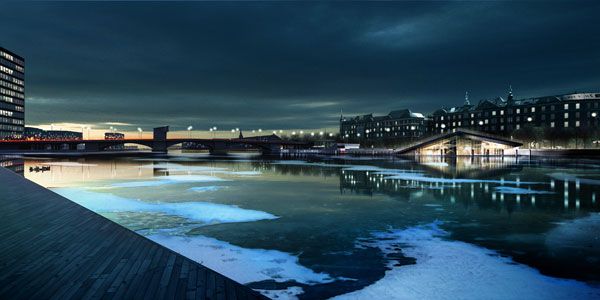
Vinterbad Brygge. Photo credit: BIG – Bjarke Ingels Group
The new facilities have been conceived as an extension of the wooden platforms that accommodate the swimming pools. They have been allocated on the southwest part of the complex. An inclined surface made of Scandinavian wood becomes the Thermal Baths roof. At the same time, the roof functions as an open-air platform for sunbathing and relaxing.
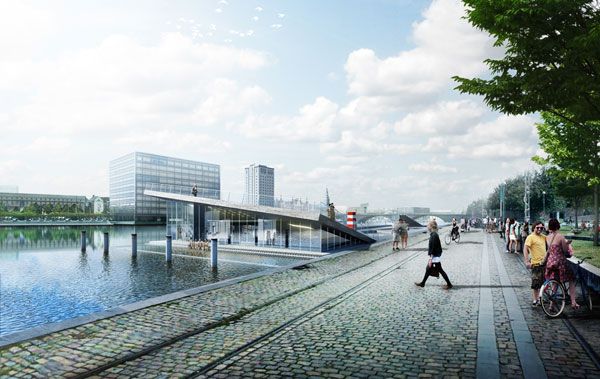
Vinterbad Brygge. Photo credit: BIG – Bjarke Ingels Group
The surface folds into a sequence of wide steps that welcome visitors to enjoy the view and the sun. The platform offers views toward the pools and the diving pier. The pier and platform heights create an interesting tension, by contradicting the horizontality of the surrounding landscape. The association with the existing adjacent park establishes a sense of continuity between the wooden platform and its surroundings.
Related Articles:
The entrance toward the Thermal Baths has been perceived as a linear crack on the wooden surface. The design intention is to intensify the transcendence from the exterior to the interior and becomes a prelude of the bath ritual. The spatial atmosphere resembles the spirituality of a temple entrance. The interior of the baths is divided by mirrored walls, giving a sense of a spatial infinity by blurring the boundaries between the different rooms.

Vinterbad Brygge. Photo credit: BIG – Bjarke Ingels Group
The exterior façade made of full-height glass panels connects the inside and the outside and opens the view toward the water surface. The glass façade is an innovative adaptation on the privacy that characterizes spaces related to bathing. Instead of designing an introverted space with filtered natural light and limited views to the outside, like most similar facilities, the architects have followed a different approach.
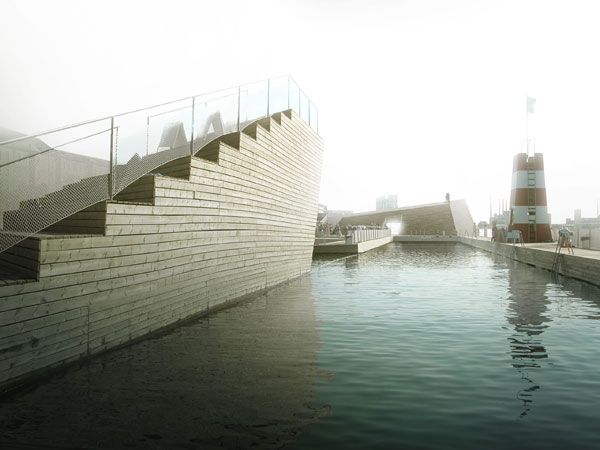
Vinterbad Brygge. Photo credit: BIG – Bjarke Ingels Group
They have allowed light and views of the city on a part of the building that one can observe from, and yet not become an object of observation themselves. The glass facades are adjacent to the water surface and combine privacy with a chance for reverie while enjoying one’s bath.
Remembering the Importance of Tradition BIG has managed to design contemporary bath facilities with a clear reference to tradition. The designers have evaded the trap of reproducing forms and have opted to adopt basic principles such as the atmosphere of mysticism, the sense of isolation, and reflection as a state of mind as well as a material quality.
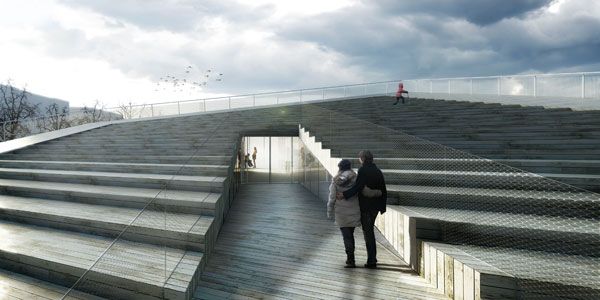
Vinterbad Brygge. Photo credit: BIG – Bjarke Ingels Group
Another creative inspiration from the past can be observed in the floor design. The entire floor is covered with black and white ceramic mosaics with motifs by HuskMitNavn. He is a famous artist who lives in Copenhagen. The artist’s name means “Remember my Name”. HuskMitNavn is known for his controversial, humorous, and political street art. The images on the floor of the baths depict contemporary Copenhagen scenes and activities. The use of ceramic mosaics originates from the Roman thermal baths.
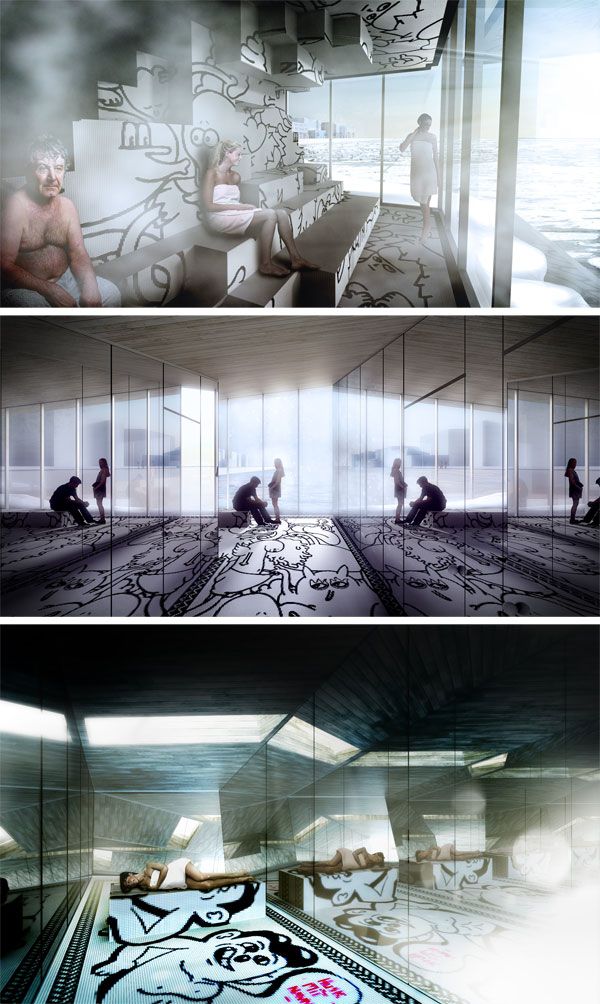
Vinterbad Brygge. Photo credit: BIG – Bjarke Ingels Group
During winter, the Thermal Baths’ glass façade functions as a lantern that can be observed from the islands of Brygge and Kalvebod Brygge. It appears as if the seawater and the baths’ warmth have merged into one, shedding new light on Copenhagen Harbour. The activity of bathing is based on contrasts: hot and cold, submerge and emerge, shade and light. The Thermal Baths in Copenhagen Harbour have transformed the qualities of the bathing ritual into vibrant, innovative architecture.
Recommended reading:
Article by Eleni Tsirintani Return to Homepage
Published in Blog








